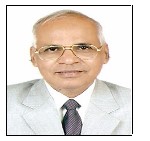
The projects of mass rapid transport in India have now taken up speed. The
metro will be electrified at 25kV AC everywhere in India except
Bangalore and Kolkata which will have 750V DC third rail system.
Both systems have got some merits and demerits. The strong points of both should
be considered before recommending a system of electrification for any metro
system. The system of electrification, once chosen will be final and cannot be
changed once the metro system is commissioned. 25kV traction is suitable for the
heavy haul trains and where high speeds are needed. The horse powers of the electric
locomotives are up to 6000 HP and thus they need lot of power. Even with the
locomotives of this size the current in the OHE of Indian Railways never exceeds
600A, the capacity of the conductors. It is for keeping the value of current low,
25kV AC is preferred over 1500V DC system. But in metros, the current will be
nowhere near the maximum current carrying capacity. For example, Mumbai metro
line one will have 84 coaches in six coach formations; including standby and the
maintenance spares. The load current in metro railways may be less than 100 Amp.
Central Railway has 60x12 car rakes and 54x9 car rakes. Four 25kV substations
are planned to meet the demand of goods, passengers and EMU services between
CST Mumbai and Kalyan. Metro will have one substation for 24 coaches as against
one substation for every 300 coaches in railways.
The need of 25kV on railways is therefore apparent. With ever increase in
demand of commuters, there is a plan to make 12 car rakes into 15 car rakes.
There is absolutely no possibility of adding more coaches in metro system as
extension of platforms in metro system after commissioning is ruled out. 1500V
DC system in Mumbai served well till late when the traffic had not increased to
demand 12-car and 15-car rakes. Conversion of 1500V DC to 25kV was
required due to uniformity of traction with other parts of India. Therefore, what
is suitable for India cannot be straightaway considered as suitable for the
elevated metros.
There are few other areas which make an interesting comparison of both types
of tractions.
A. DESIGN
Motor coaches: A motor coach of 25kV
system needs a transformer. The axle
weight of the AC motor coach is therefore
more. For the same traction motor, the
D.C. motor coach with less weight will
accelerate faster. The journey time for dc
rake will be less than the ac rake. The
requirement of rakes in dc system for the
same PPHPD will be less. The axle weight
being less, the civil structure is subjected
to less direct load. The bending movement
due to wind load on OHE conductors will
be absent in third rail system.
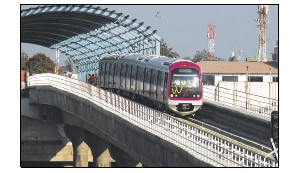 Earthing:
Earthing: The 25kV AC systems needs
elaborate earthing. Since the concrete is non-conducting, the rail and the buried earth conductor are
connected at an interval. A separate earthing rod runs through
the pier and is also in contact with the reinforcement. Such
elaborate arrangement in 750 VDC is not needed. The voltage in
third rail is low; the negative rail is near the positive rail, the
leakage current will not flow to the earth in third rail system.
Equipments for electrification: The equipments for the 750
DC third rail systems are simpler. 25kV AC system needs
catenary wire, contract wire, overhead protection conductor
and return conductor. In addition, the system needs over head
structures, structure bonds, bracket assemblies, insulators,
booster transformers etc. The 750V DC systems needs only
additional rail which is supported on low voltage insulators.
Maintenance: The manpower required for maintaining the
equipment with multiple conductors at height is more than
that required for maintaining a single power rail at rail level.
A special maintenance vehicle is needed to maintain the OHE.
The AC motor coaches need additional maintenance facilities
for transformer. The maintenance of 25kV AC systems is
therefore, expensive.
Energy loss: The strong point in favour of 25kV AC is lower
current in OHE resulting in less energy loss in conductors.
This is true. But this is important when the load currents are
heavy. The currents in metro system are small compared to the
railway systems. The 25kV AC is therefore more useful for
main lines. In third rail system, the energy loss can be reduced
by the use of aluminium rail having less resistance than the
normal rail.
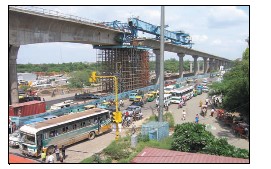
While comparing the energy loss, the additional loss taking
place in AC motor coaches due to transformers should be
considered. Whether or not the train moves, the transformer
will consume 5 per cent of the power due to iron loss and
additional 2 per cent as copper loss when running. The weight
of the motor coach in 750V DC is less due to absence of
transformers. The motor coach therefore, has to carry less
weight which results into less consumption of energy.
D.C. link voltage: 25kV systems can provide the higher dc
link voltage to enable designing of motors high power to
weight ratio. But, this problem can be taken care of by
powering some or all axles of trailer coaches. Bangalore
metro has got a traction motor of 190KW as against 220KW
in Mumbai, but the acceleration and the maximum speed is
same in both cases.
Use of non-standard voltage: If it is considered beneficial to
use AC system for some reason, the use of non-standard
voltage can be thought of. If the distribution network is at
33kV, use of 19kV in place of 25kV will eliminate the need of
traction substations completely. In case the distribution is at
22kV, use of 12kV may be considered to get the similar
advantage. It will be possible to get the same dc link voltage
with 19kV or 12kV.
Underground system: Third rail provides unique advantage
for underground system. The tunnel size will be reduced by
about 19 per cent. The muck to be handled also gets reduced.
The ramps leading to the tunnel are smaller lengths.
Regeneration: 25kV system has been favored due to
regeneration done resulting into saving of energy. But it
may be noted that regeneration is not limited to 25kV
system. The regeneration is made possible by the use of
three phase traction motor. Both third rail system and
25kV system use three phase traction motor. In third rail
system, another train absorbs the regenerated power. In
case there is no train to absorb it, the power is dissipated in
the resistances called AARU. In Kuala Lampur monorail in
Malaysia where AARU has been provided, the need to waste
energy in AARU rarely arises.
Substations: The third rail needs more number of
substations as compared to the 25kV system. Though the size
of dc substation is small, getting space for the substations in
metro cities is always a challenge. But with use of dry type
transformers, it is possible to erect elevated substations at the
end of the platform.
B. SAFETY
Parallelism of transmission lines: The metro cities can have
high voltage transmission lines. These lines can run parallel to
the metro alignment and will induce considerable voltage in
25kV AC lines. The transmission lines may have to be made
underground from safety considerations. For third rail
system, such lines need not be made underground.
Ground fault: Earth is a good conductor of electricity but the
concrete is not. The resistance of the concrete is much higher than the earth. The resistance will also depend upon the cracks in the
concrete, moisture content, age of concrete and the point at which
the conductor comes in contact with concrete.
If the parted 25kV AC conductor falls on the concrete and
the fault is not cleared by the circuit breaker, dangerous
condition will arise.
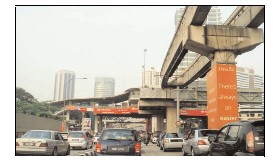
In another scenario, if the parted conductor hangs below the
viaduct, it will endanger the safety of the road users. In yet
another scenario, if the parting takes place above the railway
crossing and the power is not switched off, wrong phase coupling
can result. The substations of metro and railways will have to be
interconnected through SCADA to avoid for wrong phase
coupling. Such need will not arise with third rail system.
Pantograph entanglement: The pantograph entanglement
often results into breaking of pantograph parts like nut bolts,
copper strip hoses and sometimes entire pantographs get
uprooted. These parts often get thrown off. If these parts fall
outside the via duct, they can endanger the safety of road users.
Electromagnetic and electrostatic induction: 25kV can
induce voltage in internet cables, TV cables and metallic
structures like grills etc. Adequate study in this area is needed.
Crossing of TV cables: Large number of cables for the TV
connections runs on the roads, some parallel, some across.
The cables running parallel to the alignment will have an
induced voltage. In case of breakage of TV cable crossing
tracks, it will fall on the 25kV line and create unsafe condition
for the people whose houses are served by these cables. Since
these cables are without any protective system, the fault will
not get cleared till the wire burns out. A legislation to ban such
wires crossing the 25kV AC may be necessary.
Use of OPC and BEC: Overhead protection conductor (OPC)
and buried earth conductor (BEC) are required for 25kV AC
traction for elevated lines. They are not needed for railways
since the railway line runs at grade. The OPC is an ACSR
conductor. This conductor can break at the support point. For
the transmission line, double string insulators are used at the
road and railway crossing to reduce the probability of the
conductors falling down. The OPC if falls down on road where
the road traffic is heavy will create unsafe condition.
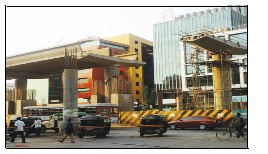
The buried earth conductor is supported on sides of the
viaduct. BEC, rail and OPC run in parallel. Since the joint
between rail and the ACSR conductor (BEC) will be a
bimetallic contact, these joints are expected to give problems
sooner or later. There have been some theft cases of BEC
reported. In the absence of this conductor, the return current
may flow to the ground through rain water. Rainwater is pure,
but accumulated dust on the viaduct will make it conducting.
C. COST COMPARISON OF PRESENT
PROJECTS
The comparison of costs in metro projects is difficult since the
funding structure of the projects differs. The problems vary
from project to project. Since the length of the lines are small,
the per kilometer costs varies significantly. There are some
hidden costs and hidden benefits. The comparisons purely on
the basis of the cost will be misleading (See table.)
Untitled Document
Metro Rail Cost Comparison |
| Metro |
Total
(`crore) |
Length
(km) |
Cost/km
(`crore) |
| Kolkata |
4,676 |
13.8 |
340 |
| Hyderabad* |
16,375 |
71.2 |
230 |
| Chennai |
2,598 |
8.6 |
302 |
| Mumbai-Line 1 |
2,356 |
11.4 |
207 |
| Mumbai-Line 2 |
8,250 |
32.0 |
258 |
| Bangalore |
8,158 |
42.3 |
193 |
| *Include real estate development cost |
The costs tabulated for all the projects are the overall costs of
the Projects which includes civil engineering cost, rolling stock,
signaling cost and other usual costs. The other conditions
remaining same, the cost of third rail system will be less.
D. KNOWN AREAS OF COMPARISON
In addition to the above points, there are some points often
indicated while comparing the two systems.
Visual Appeal: The third rail system does not need overhead
lines and therefore the skyline does not get affected. In many
places, the third rail was recommended primarily to avoid
unsightly poles and overhead wires.
Robustness: The third rail systems are more robust than
overhead lines. The conductor rail is able to take higher
mechanical forces than the over-line conductors. There are
many current collecting shoes. Even if one of the shoes is
damaged, the train can continue its journey.
Flyovers: Occasionally, flyovers have to be constructed over
the existing metro lines. The height of the flyovers for 25kV
AC systems will be more.
E. CONCLUSION
While choosing 25kV traction, attention should be given
to safety. For the underground application, third rail will
be desirable.
(S.P. Khade is Director—Technical,
Mumbai Metropolitan Region Development Authority)